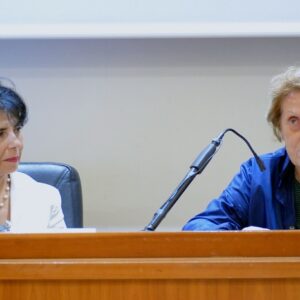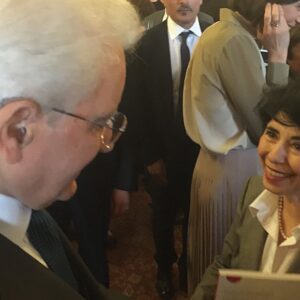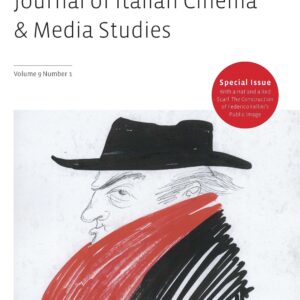On 27th October 2019, Lina Wertmüller received the Honorary Award at the Governors Awards in Hollywood. In her acceptance speech, translated by Isabella Rossellini, the director half-jokingly asked the Academy to create an ‘Oscarina’ prize for female directors and to give the statuette a girl’s name, ‘Anna’. In reaction to this mocking and provocative joke, the women in the audience present for the ceremony applauded her as a sign of fellowship and respect. Lina Wertmüller was the first woman to be nominated for Best Director in 1977 for the film Pasqualino Settebellezze (Seven Beauties). After her, in Italy it was only Cristina Comencini who received a nomination for Best Foreign Film for the 2005 film La bestia nel cuore (Don’t Tell).
The conferment of the Honorary Award gives recognition to Wertmüller’s artistic journey, an internationally renowned filmmaker whose cinema is interested in the changing of traditions, tastes and national culture and which secured this extraordinary title to the director, for her great contribution to the history of global cinema.
The academic world has always followed with remarkable interest the transformations of Italian cinema, both in the national and the international contexts, by reflecting on its influence, authority and prestige. It is from the intent to revisit Italian cinema’s inspiring presence within the global scenario that the Journal of Italian Cinema & Media Studies (JICMS) was founded in 2012. It is the first quarterly English-language journal that engages in a theoretical, methodological and critical debate on Italian film and media production, reception and consumption. It provides a platform for dialogue between academics, filmmakers, cinema and media professionals and of course, the interested public. Published by the British publishing house Intellect and co-sponsored by Wellesley College, apart from academic papers, the journal includes interviews with artists, translations of historical documents, book and film reviews, news and reports on conferences, festivals and other events linked to Italian cinema and media, as well as biographies of emerging and independent artists.
The editorial and academic success of the journal prompted its Principal Editor, Flavia Laviosa, to launch and edit a new book series in English, Trajectories of Italian Cinema and Media. In our conversation with Professor Flavia Laviosa, we delve into the global influence of Italian cinema and we ask her about the role played by JICMS in the renewed proliferation of academic studies on Italian cinema.
Professor Laviosa, what has been the international influence of Italian cinema?
“The Experimental Center of Cinematography (Centro Sperimentale di Cinematografia [CSC]) was founded in 1935 in Rome and it is one of the oldest film schools in the world, second only to the Soviet schools in Moscow and Leningrad, established in 1919. Thanks to the CSC’s 85 years of didactic activity (1935-2020), the greatest Italian and foreign filmmaking artists were trained in Italy. The Center has always paid great attention to international students and, for many nations, their student’s attendance was particularly significant since it contributed to the development of innovative and experimental film industries, especially in the 1950s and 1960s when the Centre was one of the very few film schools in the world. The artistic education in Italy, together with the esteem in which Italian cinema was held abroad, encouraged the expansion of a certain type of cinema that inspired many foreign filmmakers.

Italian cinema, therefore, being so followed and loved, studied and imitated, honored and disseminated, has always had a strong influence on the films of artists around the world. It has also been imported and exported, transferred, translated, adopted, adapted and re-interpreted. The lure of Italian cinema’s legends and the interest in revisiting its genealogy create bridges across global artistic languages. The scholars that JICMS publishes revisit the historiography of Italian cinema and media and trace the evidence of their international influence and resonance. Italian cinema and media have always moved in many directions, constantly intersecting with other cinemas, particularly with Europe, North and Latin America, Asia, Africa, and the Middle East, JICMS pays particular attention to these intersections.”
What inspired you to launch the Journal of Italian Cinema & Media Studies (JICMS)?
“Well, Professor Bullaro, you participated in the debut of this journal and, in your fundamental role of our first Associate Editor, you helped outline its objectives. And still today, as a member of the Advisory Board you continue to take part in the selection of article proposals and in the implementation of important changes in the journal, so this is nothing new to you. As you know, the journal offers a new space to those academics researching the history, theory and criticism of Italian cinema and media, its production processes and its influence on international cinema, with the collaboration of an editorial committee that includes international academics from Argentina, Australia, Canada, Ireland, Italy, New Zealand, The Netherlands, United Kingdom and United States of America.”

What distinguishes JICMS from other academic journals on cinema?
“JICMS is different from other journals for two main reasons. First of all, it promotes and welcomes the input of writers from various disciplines that are complementary to the canon of the humanities. Moreover, an absolutely distinctive trait of JICMS is its media component. The current and diverse proliferation and the rapid transformation of the media, from television, to video installations, film digitization, mobile telephony, social media and online texts have led the scholars to reconsider many theoretical assumptions. JICMS aims to open broad horizons in which a reflection on new media can take place.”
In what way does JICMS contribute to the global debate on cinema, national identity and post-nationalism?
“Within the debate on a post-national cinema JICMS presents Italy as the unifying geo-cultural place. The journal therefore aims to elaborate a multifaceted definition of Italian cinema, going beyond geographical borders and moving away from merely self-referential and self-celebratory local cinematic experiences. The journal engages with Italophone filmmakers and devotes a serious critical academic attention to diasporic cinema. Furthermore, the journal also invites reflections on the influence of Italian cinema within a global context. For this purpose, various issues have been dedicated to the intersection between Italian cinema and European, Asian (China, India, Japan), and North American (Canada and USA) cinemas.”
The journal publishes special issues as well. How is the decision to prepare these issues on a specific topic taken?
“In fact, in 2015 the journal dedicated a double issue to celebrate RAI’s 60 years of existence (1954-2004) with a collection of articles written by international scholars with an expertise in Italian television. Another special issue was published in 2016 in collaboration with the Academy of Italian Cinema David di Donatello Awards in order to celebrate the 60th anniversary of the David di Donatello Award (1956-2016).
During the celebration of the 60th anniversary of the David di Donatello award at the Quirinale Palace, JICMS received special recognition from the President of the Italian Republic, Sergio Mattarella.

Two new special issues are in the works to celebrate the birth centenary (1920-2020) of Federico Fellini and Tonino Guerra. With the choices of these topics, therefore, the journal aims to celebrate important historical moments of Italian cinema and its great masters. The aim of these editorial decisions is to complement the film industry and to be part of the artistic community with articles that reflect on history and that revisit it in retrospect in a critical manner. If the film industry creates film art, the academic community gives rise to film culture and thought. JICMS is present and participates in this dialogue between creative ingenuity and critical reflection.

In collaboration with Professor Catherine Ramsey-Portolano, and Milly Buonanno, we have also organized two international conferences: Innovations and Tensions in Italian Cinema and Media in 2017 and Global Intersections and Artistic Interconnections: Italian Cinema and Media Across Times and Spaces in 2019, both held at The American University of Rome, which saw the participation of academics from all over the world and noted directors Liliana Cavani, Emanuela Piovano e Gianfranco Angelucci as guests.”
After the great success of the journal, you founded the book series Trajectories. Could you tell us more about it?
“The JICMS journal has enjoyed academic and publishing success from the moment of its inception in 2012. The number of articles proposed and then rigorously selected has always been significant, so
much so that it is not possible to publish them all, notwithstanding their value and critical relevance. This encouraged me to initiate the series Trajectories of Italian Cinema and Media in 2019, published by Intellect, which welcomes proposals for monographs and edited volumes.

Alongside the journal, the book series intends to engage with diverse academic communities with the aim to explore new critical and historical directions. Trajectories seeks to trace the evidence of Italian cinema’s international resonance and influence, to define the extent of its inspirational force, to examine other cinemas’ artistic innovations resulting from their osmosis with the Italian film tradition and, finally, to foster comparative analyses of themes and genres between Italian and other world cinemas. This series also intends to address the emerging interdisciplinary critical approaches towards Italian cinema and media.
Lastly, Trajectories plans to systematically analyze those forms of cinema and media that are still unknown, to (re)discover their traces, influences and manifestations in other countries, so that the New History of Italian cinema and media is written.”
What has already been published in the Trajectories series and what will be published in future?
“The first volume in the series has just been published, Fellini’s Films and Commercials: From Postwar to Postmodern by Frank Burke. In January 2021, the series will publish the collective volume Paolo Sorrentino’s Transnational Cinema and Television: An Eclectic Harmony edited by Annachiara Mariani. Furthermore, two monographs on RAI’s history from the 1950s to the present day are currently in progress and will be published in 2022.”
How is your commitment to Italian film studies reflected in the teaching you carry out at Wellesley College?
“I am a lecturer in the Department of Italian Studies and the Cinema and Media Studies Program and I teach units on Italian and European female filmmakers. This reflection on a cinema distinguished by female filmmakers’ signature aims to highlight the contribution made by the great women directors, and to trace a connective thread between them that goes across time and space, to determine their thematic and stylistic choices, and to promote their artistic contribution as a form of social engagement and civil activism.
In the unit Italian Women Directors: The Female Authorial Voice in Italian Cinema, we examine the films of the greatest female filmmakers across different generations: Liliana Cavani and Lina Wertmüller in the 1970s, the Comencini sisters Cristina and Francesca, Francesca Archibugi and Emanuela Piovano in the 1990s and 2000s, Laura Bispuri and Alice Rohrwacher in the 2010s.”
What are the challenges faced by a journal editor?
“It is a great honor for me to edit an international journal, primarily with the support of a very professional publishing house such as Intellect, but also with the collaboration of the colleagues who are on the Editorial Board with whom proposals and initiatives are shared, with the input of the voluntary assistants, and with the intellectual vigor of writers working on innovative research projects that enrich the heritage of Italian cinema and media studies. In my role as a director, the exciting and stimulating challenge lies in giving to the journal a brave soul and a pioneering nature so as to guide it in the discovery of unexplored domains.”
What are Italian cinema’s future objectives?
“Balancing history and innovation, tradition and progress, artistic talent and new technologies. Committing to the exploration of new stylistic frontiers, experimenting with different expressive languages, and being open to a transnational dialogue and an international exchange so as to avoid resorting to provincialism and to give in to self-referentiality. These are the objectives of a future-oriented Italian cinema.”
Translated by Glen Bonicci, University of Malta












